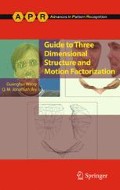Abstract
The chapter investigates geometrical properties of quasi-perspective projection model in one and two-view geometry. The main results are as follows. (i) Quasi-perspective projection matrix has nine degrees of freedom, and the parallelism alongX andY directions in world system are preserved in images. (ii) Quasi-fundamental matrix can be simplified to a special form with only six degrees of freedom. The fundamental matrix is invariant to any non-singular projective transformation. (iii) Plane induced homography under quasi-perspective model can be simplified to a special form defined by six degrees of freedom. The quasi-homography may be recovered from two pairs of corresponding points with known fundamental matrix. (iv) Any two reconstructions in quasi-perspective space are defined up to a non-singular quasi-perspective transformation.
Euclid taught me that without assumptions there is no proof. Therefore, in any argument, examine the assumptions.
Eric Temple Bell (1883–1960)
Access this chapter
Tax calculation will be finalised at checkout
Purchases are for personal use only
References
Cheng, C.M., Lai, S.H.: A consensus sampling technique for fast and robust model fitting. Pattern Recogn.42(7), 1318–1329 (2009)
Dellaert, F., Seitz, S.M., Thorpe, C.E., Thrun, S.: Structure from motion without correspondence. In: Proc. of IEEE Conference on Computer Vision and Pattern Recognition, pp. 2557–2564 (2000)
Faugeras, O.: Stratification of 3-D vision: projective, affine, and metric representations. J. Opt. Soc. Am. A12, 465–484 (1995)
Fischler, M.A., Bolles, R.C.: Random sample consensus: A paradigm for model fitting with applications to image analysis and automated cartography. Commun. ACM24(6), 381–395 (1981)
Guilbert, N., Bartoli, A., Heyden, A.: Affine approximation for direct batch recovery of Euclidean structure and motion from sparse data. Int. J. Comput. Vis.69(3), 317–333 (2006)
Hartley, R.I.: In defense of the eight-point algorithm. IEEE Trans. Pattern Anal. Mach. Intell.19(6), 580–593 (1997)
Hartley, R.I., Zisserman, A.: Multiple View Geometry in Computer Vision, 2nd edn. Cambridge University Press, Cambridge (2004). ISBN: 0521540518
Hu, M., McMenemy, K., Ferguson, S., Dodds, G., Yuan, B.: Epipolar geometry estimation based on evolutionary agents. Pattern Recogn.41(2), 575–591 (2008)
Lehmann, S., Bradley, A.P., Clarkson, I.V.L., Williams, J., Kootsookos, P.J.: Correspondence-free determination of the affine fundamental matrix. IEEE Trans. Pattern Anal. Mach. Intell.29(1), 82–97 (2007)
Mendonça, P.R.S., Cipolla, R.: Analysis and computation of an affine trifocal tensor. In: Proc. of British Machine Vision Conference, pp. 125–133 (1998)
Mundy, J.L., Zisserman, A.: Geometric Invariance in Computer Vision. MIT Press, Cambridge (1992)
Oliensis, J., Hartley, R.: Iterative extensions of the Sturm/Triggs algorithm: Convergence and nonconvergence. IEEE Trans. Pattern Anal. Mach. Intell.29(12), 2217–2233 (2007)
Torr, P.H.S., Zisserman, A., Maybank, S.J.: Robust detection of degenerate configurations while estimating the fundamental matrix. Comput. Vis. Image Underst.71(3), 312–333 (1998)
Poelman, C., Kanade, T.: A paraperspective factorization method for shape and motion recovery. IEEE Trans. Pattern Anal. Mach. Intell.19(3), 206–218 (1997)
Shapiro, L.S., Zisserman, A., Brady, M.: 3D motion recovery via affine epipolar geometry. Int. J. Comput. Vis.16(2), 147–182 (1995)
Shimshoni, I., Basri, R., Rivlin, E.: A geometric interpretation of weak-perspective motion. IEEE Trans. Pattern Anal. Mach. Intell.21(3), 252–257 (1999)
Wang, G.: A hybrid system for feature matching based on sift and epipolar constraints. Tech. Rep. Department of ECE, University of Windsor (2006)
Wang, G., Wu, J.: Quasi-perspective projection with applications to 3D factorization from uncalibrated image sequences. In: Proc. of IEEE Conference on Computer Vision and Pattern Recognition, pp. 1–8 (2008)
Wang, G., Wu, J.: Perspective 3D Euclidean reconstruction with varying camera parameters. IEEE Trans. Circuits Syst. Video Technol.19(12), 1793–1803 (2009)
Wang, G., Wu, J.: The quasi-perspective model: Geometric properties and 3D reconstruction. Pattern Recogn.43(5), 1932–1942 (2010)
Wang, G., Wu, J.: Quasi-perspective projection model: Theory and application to structure and motion factorization from uncalibrated image sequences. Int. J. Comput. Vis.87(3), 213–234 (2010)
Weng, J., Huang, T., Ahuja, N.: Motion and structure from two perspective views: Algorithms. IEEE Trans. Pattern Anal. Mach. Intell.11(5), 451–476 (1997)
Wolf, L., Shashua, A.: Affine 3-D reconstruction from two projective images of independently translating planes. In: Proc. of International Conference on Computer Vision, pp. 238–244 (2001)
Zhang, Z.: A flexible new technique for camera calibration. IEEE Trans. Pattern Anal. Mach. Intell.22(11), 1330–1334 (2000)
Zhang, Z., Anandan, P., Shum, H.Y.: What can be determined from a full and a weak perspective image? In: Proc. of International Conference on Computer Vision, pp. 680–687 (1999)
Zhang, Z., Kanade, T.: Determining the epipolar geometry and its uncertainty: A review. Int. J. Comput. Vis.27(2), 161–195 (1998)
Zhang, Z., Xu, G.: A general expression of the fundamental matrix for both projective and affine cameras. In: Proc. of International Joint Conference on Artificial Intelligence, pp. 1502–1507 (1997)
Author information
Authors and Affiliations
Corresponding authors
Rights and permissions
Copyright information
© 2011 Springer-Verlag London Limited
About this chapter
Cite this chapter
Wang, G., Wu, Q.M.J. (2011). Geometrical Properties of Quasi-Perspective Projection. In: Guide to Three Dimensional Structure and Motion Factorization. Advances in Pattern Recognition. Springer, London. https://doi.org/10.1007/978-0-85729-046-5_3
Download citation
DOI: https://doi.org/10.1007/978-0-85729-046-5_3
Publisher Name: Springer, London
Print ISBN: 978-0-85729-045-8
Online ISBN: 978-0-85729-046-5
eBook Packages: Computer ScienceComputer Science (R0)

